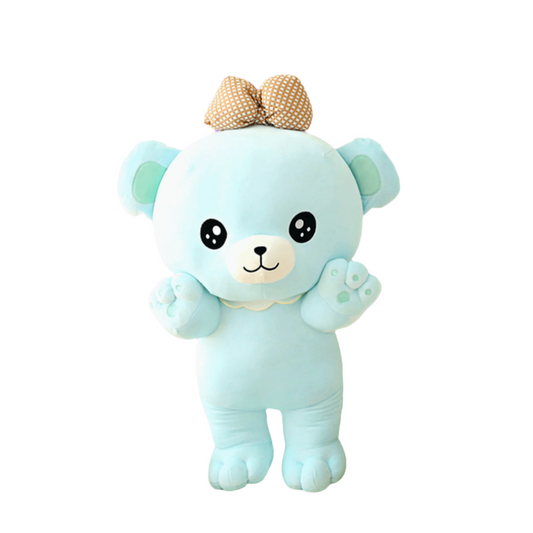When was the First Plushie Made?
Plushies, those soft and cuddly stuffed animals that have become beloved companions to children and adults alike, have a long and fascinating history. These huggable toys have brought comfort and joy to generations, but have you ever wondered when the very first plushie was made? Who the ingenious minds behind these cuddly companions were? Join us on a journey through time to uncover the fascinating history of the first stuffed animals and the visionaries who brought them to life.
The Inventors: Margarete and Richard Steiff, and Morris Michtom
The true pioneers of stuffed animals, however, emerged in the late 19th and early 20th centuries. Three remarkable individuals stand at the forefront of this revolution: Margarete Steiff, Richard Steiff, and Morris Michtom.
Margarete Steiff
Margarete Steiff, a German entrepreneur with a passion for sewing, holds a special place in the history of stuffed animals. In 1879, she embarked on a journey that would change the world of toys forever. Margarete began by sewing patterns for an elephant, a charming creation that would mark the inception of stuffed animals as we know them today. What started as a humble endeavor soon gained international acclaim, and Margarete's creations became beloved companions to children worldwide. Her enduring legacy continues to bring comfort and smiles to generations.
Richard Steiff
Richard Steiff, Margarete's nephew, played a pivotal role in the evolution of stuffed animals. Recognizing his aunt's remarkable talent, Richard ventured into designing other animals, expanding the range of plush companions available to children. He also co-founded the Steiff company in 1880, contributing to its reputation as a renowned purveyor of quality plush toys. Throughout its history, the company has been honored with numerous awards and accolades, cementing its place as a leader in the world of stuffed animals.
Morris Michtom
In the post-World War II era, Morris Michtom and Rose Katz embarked on their own journey into the world of stuffed animals by founding the Ideal Toy Company. Their breakthrough came in 1934 when they introduced Betsy Wetsy and Shirley Temple rag dolls, providing comfort and entertainment during the challenging years of the Great Depression. Their innovative creations not only brought joy to children but also played a role in stabilizing the economy during a tumultuous period.
The Oldest Stuffed Animal in the World
In the annals of stuffed animal history, the honor of being the oldest stuffed animal goes to Margarete Steiff's elephant, created in Germany during the 1880s. Initially crafted as a pin cushion, it quickly gained popularity among children, leading to mass production.
Alongside the elephant, other timeless stuffed toys like sock monkeys and Peter Rabbit have brought joy to countless children, especially those who couldn't access pricier plush toys. Margarete Steiff's innovative use of technology played a crucial role in improving the quality and accessibility of these beloved toys during her era.
Iconic Plushies
Throughout the years, certain plushies have become iconic in their own right. The "Steiff Bear," created by the German company Steiff in the early 20th century, is considered one of the earliest teddy bears and remains highly sought after by collectors. Other iconic plushies include the "Winnie the Pooh" bear and the "Paddington Bear," both of which have captured the hearts of generations.
Frequently Asked Questions
Why Were Stuffed Animals Invented?
Stuffed animals were invented to bring joy to children who could not afford the intricate wooden animal carvings available to wealthier families during Ancient Rome. Rag dolls, crafted from straw and rags, were created to offer comfort and playfulness to children from all walks of life.
What Country Invented the Teddy Bear?
The Teddy Bear was invented in the United States, with its origin traced to Washington, under the care of Morris Michtom. The inspiration for the Teddy Bear came from a Washington Post cartoon depicting President Teddy Roosevelt's merciful act of sparing a bear during a hunting expedition. This heartwarming story led to the global popularity of the Teddy Bear.
So, Who Invented Stuffed Animals?
Stuffed animals were first created by Margarete Steiff, a German entrepreneur known for her talent in sewing. She began by crafting delightful animals like elephants and pin cushions for her close friends. Her creations quickly gained popularity, becoming one of the most cherished toys of the 20th century. Margarete's vision and creativity laid the foundation for the world of stuffed animals we know today, evolving from humble beginnings to a source of comfort and companionship for generations.
When Did Stuffed Animals Become Mass-Produced Toys?
The mass production of stuffed animals began in the late 19th and early 20th centuries with the efforts of pioneers like Margarete Steiff and Richard Steiff. Their innovative techniques allowed for the widespread availability of stuffed animals, making them accessible to children worldwide.
What Were the Early Materials Used in Making Stuffed Animals?
When was the first plushie made?
Early stuffed animals were often crafted from simple materials such as straw, wood, and rags. These readily available materials made the toys affordable, allowing children from various socioeconomic backgrounds to enjoy them.
How Did Stuffed Animals Evolve Over Time in Terms of Materials?
Over time, the materials used in stuffed animals evolved. Traditional materials like straw and rags gave way to more comfortable and durable options, such as cotton and plush fur-like fabric. Today's stuffed animals often feature a combination of plush fabrics and soft stuffing, providing both cuddliness and durability.
What Role Did Stuffed Animals Play During Historical Difficult Times?
Stuffed animals, including the Teddy Bear and dolls like Betsy Wetsy, played a significant role during challenging periods like the Great Depression. These comforting companions provided solace and entertainment to children, contributing to their well-being during times of economic hardship.
















